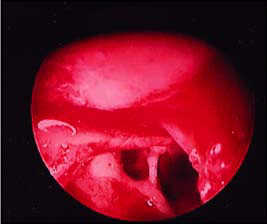Endoscopic mastoid surgery is difficult to learn, performed in a tight space, and will probably never replace conventional open procedures. That’s the bad news. The good news is that it is a less invasive second-look procedure than conventional surgery, it is bone-sparing, and it can reduce the frequency with which an otolaryngologist does open repeat procedures.
Explore This Issue
May 2007In separate interviews with ENToday, two experts in endoscopic mastoid surgery discussed their experiences and their views on the place this approach has in mastoid surgery, and offered pearls that can help otolaryngologists and their surgical teams make a smooth transition to using endoscopy in mastoid procedures.

The endoscopic approach allows us to see around corners and use angled instruments that are not possible with the conventional approach, said Hamed Sajjadi, MD, in a phone interview. We reduce the amount of bone that is lost in a conventional resection, and we can even reduce the need for open procedures by as much as 70 percent. Dr. Sajjadi is Clinical Associate Professor of Otolaryngology-Head and Neck Surgery at Stanford University School of Medicine and has a private practice in San Jose, CA. He gave a presentation on endoscopic mastoid surgery at the 2006 annual meeting of the American Academy of Otolaryngology-Head and Neck Surgery.1
In that presentation, Dr. Sajjadi discussed the results of combined ear endoscopic and microscopic methods in 250 consecutive cholesteatoma cases over a seven-year period. He then compared those results with more than 500 cholesteatoma cases that were performed in prior years with standard microscopic methods, and that therefore served as historical controls. In particular, he wanted to assess the degree of surgical dissection during primary surgery, the cholesteatoma recidivism rates, and the need to perform open secondary mastoid procedures during second-look surgery in surgeries with and without endoscopes.
Repeat Open Procedures Reduced
Dr. Sajjadi found that adding endoscopy to the standard microscopic surgery for cholesteatoma reduced by 80% the need to open up the mastoid during planned second-look surgeries (p = 0.005).
To perform endoscopic mastoid surgery, the otolaryngologist uses a rigid endoscope attached to a video camera, he said. The surgical field is visualized on a monitor. The procedure starts with a small incision, approximately 1 cm. If the results are clear and no diseased tissue is seen, there is no need to open up the mastoid. The surgeon can choose an instrument angled at 30° or 70°, he said.
Leave a Reply